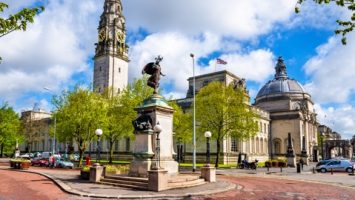
I recently spoke with Bill Skerpan, Innovation and Analytics Manager for the City of Boulder, Colorado about developing a unique smart city vision in a Denver-adjacent community. He speaks openly about the city’s strategy, the culture of innovation that propels it, and the benefits of having smart neighbors. Read more:
SCC: The Denver-Boulder area is unique in its effort toward regional collaboration. Can you tell me what that looks like, from your perspective, and what it’s like to be a smaller community near Denver with ambitious smart city goals?
SKERPAN: Boulder’s Innovation Architecture is grounded on the fact that making a city ‘smart’ is as much – if not more – about enabling our people and processes to be more effective and efficient as it is our technology. A key element of this is fostering exploration and experimentation in how we approach our everyday roles here at the city. Being a neighbor to so many like minded cities helps us share ideas person-to-person and role-to-role on issues that know no geographic boundaries. No municipality is alone in addressing such issues as equitable mobility, broader resiliency, and sustainable energy, and we have found shared eagerness from our neighbors in such forums as the Colorado Smart City Alliance to collectively progress against those challenges.
SCC: Your role in Boulder is as Innovation and Analytics Manager. Can you tell me, in layman’s terms, what that means and how it is relevant to the broader smart city conversation?
SKERPAN: Julia Richman, Boulder’s Chief Innovation and Technology Officer, established an Innovation Architecture in 2017 aimed at realizing the city’s innovation vision, improving overall city effectiveness through:
- Data-driven decision-making — better understand, collaborate with, and leverage our information assets for more effective program outcomes.
- Operational efficiency — mirror our innovative policies with internal operations practices that are shared, efficient, and online.
- Culture of innovation — reduce barriers to entry for value added changes, creative thinking, and collaboration; engage our highly talented staff in problem solving for the benefit of our entire community.
- Community as resource — find new solutions to our most pressing community challenges through new mechanisms for direct engagement with our highly talented community members.
- Exceed the expectations of constituents — use process driven continuous improvement to better serve our constituents.
These are all key elements to ground our ongoing conversations around what a smart Boulder looks like. I joined the city this past February to help our Departments execute against this vision.
SCC: You oversee the Bloomberg Mayor’s Challenge for Boulder. Winning is an incredible honor and, I am sure, a substantial responsibility. Please tell me what the Challenge entails and how it dictates, if at all, Boulder’s short and long-term goals.
SKERPAN: Along with the other 34 Champion Cities, we completed the first phase of the Bloomberg Philanthropies U.S. Mayors Challenge project and submitted our final application in August. Our efforts focused on increasing low and moderate-income residents’ access to and use of more shared, sustainable, and affordable mobility options within the city. This work emphasized how choice in mobility is a learned behavior influenced by known and trusted people. There are barriers that cannot be overcome by an app, colorful pamphlet, or free ride. Social connection is the keystone.
Boulder’s project used neighborhood-level relationships and social connections – resident “Community Connectors” – to directly deliver information paired with behavioral and price incentives to spur resident introduction to new mobility options. Compared to other tests relying solely on information and price incentives, the addition of direct, community engagement measurably expanded residents’ accessibility and openness to using new modes, thereby increasing their resiliency against unforeseen adversity and as mobility moves toward more electric, advanced, and shared modes. The city partnered with Boulder Housing Partners, CU-Boulder’s Just Transition Collaborative, Boulder B-cycle, eGO carshare, Boulder Nissan, Lyft, and the National Renewable Energy Lab (NREL) to test this engagement model in four neighborhoods and with over 1,000 households.
We learned a lot throughout the project in terms of how our city’s departments could more effectively engage harder to reach neighborhoods, but also how we can better coordinate such cross-departmental projects in the future. Such rapid project iteration and implementation is difficult in government at any level; this project helped us find and address our weak points.
We are actively integrating the results and approach from this project into on-going transportation, sustainability, and engagement initiatives, including expanding the Community Connector model to the city’s upcoming electric municipalization efforts and ongoing development of the city’s Transportation Master Plan.
We have more information online, including mobility survey data of over 200 Boulderites, here: https://bouldercolorado.gov/mayors-challenge.
SCC: Of all the components required to make city smart, which is the one that is absolutely necessary as a precursor to all others?
SKERPAN: People. It is the most critical, but also the most challenging, component of this trend toward using internet-connected devices to make our city services more efficient and effective. Any city would have a tough time moving toward a long-term plan if the employees were not out front knowledgeably identifying, exploring, implementing, and adopting such emerging technology and processes. This also applies to our ability to engage the public, a function at the heart of a lot of great engagement work being done through our city’s engagement team. We have great wealth of innovation in Boulder, and we are working hard to better tap into it.
SCC: What does ‘smart’ mean to you? How does Boulder reflect that definition?
SKERPAN: The city of Boulder has long been a national leader among innovative communities. But along with all other municipalities, we struggle to keep pace with today’s rapid, exponential change and Boulderites’ increasing expectations of their city’s ability to adopt such technology to better its services.
We see this primarily as a people and process issue – a culture issue – more than a technology issue. The technology is there, in many ways overwhelmingly so. Instead our Innovation Architecture seeks to arm all employees with the processes, tools, skills, and data resources needed to operate in this “smart” environment. Through a culture promoting exploration, experimentation, and evolution, city departments can better get their arms around challenges at the core of their services and thereby better approach emerging technologies for tomorrow’s solutions.
SCC: Innovation is, by definition, about novelty. However, cities also stand to gain by learning from one another. As the Innovation Manager, how do you work to maintain your place as a thought leader while also looking to other regions and communities to develop your strategy?
SKERPAN: Much of this role requires being present and receptive to new ideas. This responsibility is made significantly easier by the incredibly innovative community here in Boulder. Thankfully, there are many Boulder-based, regional, and national organizations – Code for Boulder, Galvanize, Analyze Boulder, CU-Boulder, Colorado Smart City Alliance, Metrolab Network, What Works Cities, to name a few – that host engaging forums to seek out innovators and their direct, frank feedback on the city’s services.
Our focus in the coming year is turning those ideas into action. This requires bolstering several, key areas, including our ability to clearly articulate persistent challenges for which our work, our partners, or the market have not yet offered solutions. As we find possible solutions we then need to be better able to shift from solutioning to testing, ever aware of how we will measure and determine success. And we also need to be comfortable chronicling our failures and what has been tried and learned from earlier efforts to address those issues.
We are lucky enough as a city to pursue many opportunities to uncover true public sector innovation. To fully realize those opportunities and turn them into beneficial outcomes for our residents, we need transparent conversations around what we cannot solve alone, where and how we have failed, and how we plan to turn those lessons learned into progress forward.
To learn more about Boulder’s work, visit with them at Smart Cities Connect Conference & Expo in Denver next April 1-4, 2019.


